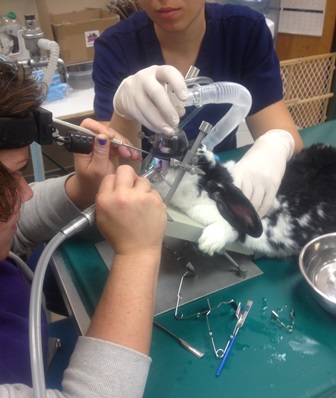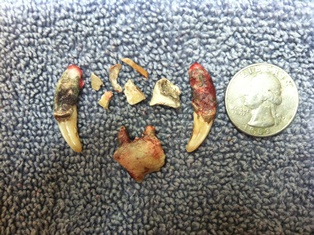Most people understand the importance of taking care of their own teeth by brushing and flossing every day along with regular professional cleanings. The honest truth is that pets need more daily care and annual cleanings than most people know. They develop dental disease at early ages and feel dental discomfort and pain just like we do – so much so that February has been deemed National Pet Dental Health Month.
Proactive preventative dental health in the past has been overlooked way too long. Veterinarians, like human doctors, now understand how important oral health is. Veterinary dental care is an essential component of a preventative health care plan.
Periodontal disease
Periodontal disease is the most common disease in pets. Seventy percent of cats and 80 percent of dogs have some form of gum disease by age two-three years old. Overlooked periodontal infection can lead to foul breath, tooth loss, tooth root abscesses, infections, jaw fractures, and even oral cancer.
Bad breath is due to bacteria. Red gums is gingivitis. Flip your pet’s lips and look at their gums and teeth. Bacteria accumulate under the gum. That liquid bacteria dives under the gums and hardens into tartar. This sits and builds on the bone surrounding your pet’s roots. The bacterial infection, if not properly cleaned under the gums, actually eats away at the roots causing bone loss. This causes pain and allows bacteria to continually enter the bloodstream. The longer and more severe the dental disease, the more painful, irreversible, and overwhelming it becomes to a pet’s immune system and organs.
People need to talk to their veterinarian about how regular professional cleanings under anesthesia can help reverse and minimize the impact of dental disease on their pet. It will help pets live years longer and pain free. Shorter, yearly professional care in healthy patients is much safer than delaying treatment requiring longer anesthesia and many extractions at one time.
Proper cleaning of the bone underneath the gum line regularly allows the bone to grow back and improves the dental stage or grade of disease. There are 4 stages or grades of Dental Disease. Periodontal disease progresses from 0 which is normal to Stage 4. The most severe or Grade 4 teeth are the most painful and can no longer be saved. At this point there is usually greater than 50 % bone loss that can never grow back. Stage 4 teeth, however, should not be left to rot. They must be found and removed to save and improve the grade of surrounding teeth and the pet’s health and well- being.
Severe dental disease can actually shorten a pet’s lifespan. Periodontal disease overlooked or left unchecked for years has been linked to many systemic diseases like lung, kidney and liver disease, heart failure and heart attacks. Many dental diseases and conditions like diabetes actually improve with regular proper professional veterinary dental cleanings and treatment.
Professional cleanings are generally recommended annually, but it depends on the pet’s breed and individual health history to determine the exact schedule necessary to maintain healthy teeth.
The importance of proper dental cleanings
Proper dental cleanings require anesthesia which involve ultrasonically scaling, cleaning, and polishing properly above and below the gum line. It also includes probing and rinsing under the gums. Dental X-rays are also the best way to improve the quality of dental care. This is especially true in pets who hide pain from their owners really well. All our lives would be easier if we had X-ray vision or if our pets could just talk. I am sure many more pets would be benefiting from a good dental plan.
Veterinary dentistry, anesthesia, and anesthesia monitoring has tremendously progressed and improved in the past 10-15 years. Anesthesia in pet patients is extremely safe now when performed correctly with all proper safeguards in place.
There are also myths out there that older patients or pets with mild to moderate disease can’t have anesthesia. Don’t allow your pet to develop long term severe disease states. Allow your trusted veterinarian to help you decide what is in your pet’s best interest. There are many health benefits with keeping up with good preventative veterinary healthcare.
What about “anesthesia free” dental cleanings?
You might have seen “anesthesia free” dental cleanings for pets promoted online or elsewhere. Beware and become aware. Anesthesia free teeth cleaning of a pet’s teeth can be a dangerous and and uncomfortable process for the pet. The description of the procedure to the pet parent is often very misleading.
Anesthesia free dentistry sounds great, but unfortunately it can do much more harm than good. A cleaning procedure with dangerous, sharp instruments used on a fully awake pet is ineffective. The procedure is stressful, traumatizing and painful to an innocent pet.
Many pets have painful cavities underneath the gum line that no one can see without proper probing and digital dental X-rays. This is why “anesthesia free” dentistry is illegal in California.
We recommend daily brushing of your pet’s teeth. This coupled with regular dental exams by your veterinarian can ensure proper treatment is given when needed. Professional, consistent deep cleaning under the gums with the use of anesthesia is a solid preventative measure to ward off dental pain and tooth loss.
Recommended Reading:
Anesthesia – is it safe
Pet dental care – case study
Why animals need anesthesia for complete dental cleaning – Ask the Vet
Dr. Joe Martins, DVM, Belle Mead Animal Hospital







